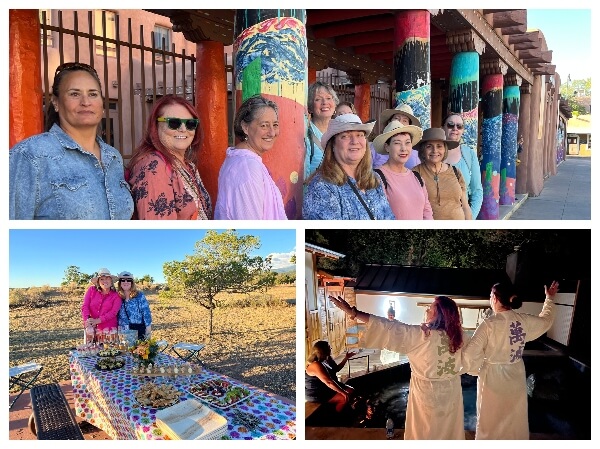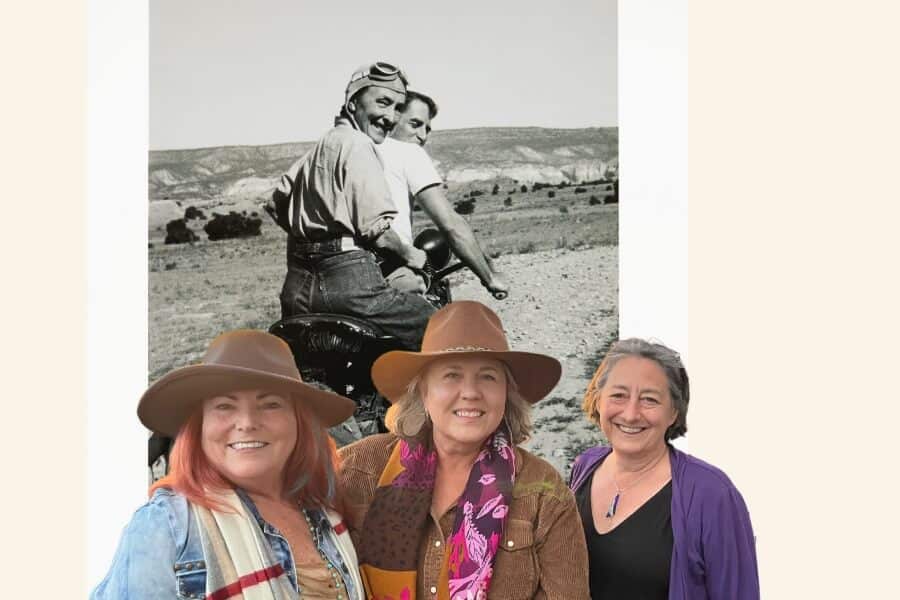When you walk into the lobby of the Georgia O’Keeffe Museum in downtown Santa Fe, one of the first things you notice is a large-as-life black-and-white photo of a laughing O’Keeffe on the back of a motorcycle, holding on to some nameless man. With her leather cap and goggles propped up on her head, she looks jaunty. Her head is turned to look over her shoulder, as if she’s inviting the photographer (and thus, us) along for the ride.
NextTribe will offer our Santa Fe trip September 25-28 2024, when the mountain air is brisk and the aspens are changing. Come along for a similar adventure to the one here. All the details, plus an easy payment plan, here.
The license plate on the motorcycle says 1944, which means O’Keeffe was at least 57 when the photo was taken. O’Keeffe spent her life bucking norms, including the one that women over a certain age should behave with decorum. As I was considering the spirit of liberation and adventure the photo captured, I heard a woman behind me say, “I wish I had the courage to go live out in the desert and make art.”
I turned to see a woman of about 70, as mesmerized by the photo as I was. She was standing next to her husband, who turned toward the photo, and gave a slight shrug before stepping up to buy a ticket.
It occurred to me that Georgia O’Keeffe was an artist in two ways. One, in how she captured the spice-rack shades of the Southwest and the other magic she worked with a brush. Two, in how she lived her life. I think her canvases are the kind of art anyone can appreciate. But the art of her life speaks almost exclusively to women.
Read More: What Would Frida Do? Lessons on Living Boldly
Georgia on Our Minds

Top: On our walking tour of Santa Fe. Bottom left, our sunset picnic at Santa Fe’s highest spot. Bottom right: A soak in a private hot tub suite at 10,000 Waves Spa.
The spirit of Georgia O’Keeffe permeated everything we did on the NextTribe trip to Santa Fe last month. Well, everything except maybe the dance-off I had with a fellow passenger on a sunset train ride through the high desert, but that’s another story.
From the moment our local guide Mollie Mitchell held up a black, flat-brimmed felt hat in a shop on our first day and said, “This is exactly the kind of hat Georgia O’Keeffe wore,” she became our reference point. When we watched Lisa Flynn, a local award-winning plein air artist, capture the rosy brown of the adobe walls near her studio, I was thinking of the subtle hues in O’Keeffe’s paintings that we had seen at the museum.
O’Keeffe must have known that strength was a prerequisite for a life here.
At a Happy Hour on a covered porch (or “portale”) overlooking the Sangre de Christo mountains, we listened to the author Jen Sincero talk about her bestselling book You are a Badass, and I immediately thought of how O’Keeffe was a badass by instinct, long before there were books to achieve that status. At a cooking class at Norma Naranjo’s home–where we slid empanadas into a traditional horno–Naranjo told us that the name of her pueblo, Ohkay Owingeh, meant “Place of the Strong People.” I thought that O’Keeffe must have known that strength was a prerequisite for a life here–that’s what drew her, that’s what allowed her to thrive.
As we drove to the famed hot springs, Ojo Caliente, the sun had just gone down, but the lingering light turned a rain cloud and the streams of rain pouring from it a vibrant pink. The object looked like a neon jellyfish floating above the horizon. The photo NextTriber Cathi Hight took is as ethereal and moving as an O’Keeffe painting.
Into O’Keeffe Land

Clockwise from top left: With bestselling author Jen Sincero at a Badass Happy Hour at a private home; dancing on a sunset champagne train; Norma Naranjo with traditional Indian fry bread at our cooking class on the Ohkay Owingeh pueblo; two NextTribers cook on the traditional horno.
Nothing, however, made us more O’Keeffe-obsessed than visits to the twin ground zeroes of the artist’s life: Ghost Ranch and her house in Abiquiu, about 15 miles away.
Since discovering it in 1934, O’Keeffe spent as much time as possible at Ghost Ranch, at the time a dude ranch. While married to the photographer Alfred Stieglitz, she divided her time between Ghost Ranch (in the summers) and New York, where Stieglitz remained even while O’Keeffe was away. Steiglitz and O’Keeffe’s relationship was a topic of conversation as we drove the one hour from Santa Fe to the ranch. Mollie, a knowledgeable O’Keeffe fan, talked about how progressive O’Keeffe was. She and Stieglitz had a torrid affair while he was married to another woman and O’Keeffe posed for nude photos for him. Mollie and her carful of NextTribers discussed how she might have prevented pregnancy back in the days before the pill.
Steiglitz and O’Keeffe’s relationship was a topic of conversation as we drove the one hour from Santa Fe to the ranch.
Our guide at Ghost Ranch gave us more to contemplate about O’Keeffe’s personal life. What prompted O’Keeffe to start coming to New Mexico, instead of spending summers with Steiglitz at his vacation home, is that he was having an affair on her and inviting his mistress to the upstate New York family getaway.
Our tour of Ghost Ranch was on a small bus, and we stopped at key locations so our guide could show us actual trees, hills or vistas O’Keeffe had painted. The dusty road we traveled was the same one O’Keeffe drove along in a Model A car she turned into a mobile studio. One side of the road, to the north, O’Keeffe called her “front yard.” The other side, to the south, was her “back yard.” The horizon in her back yard was dominated by the profile of the mountain called Cerro Pedernal. She painted the flat-topped projection often; she even once told an interviewer that God said if she painted it often enough, he would give it to her. (After her death, her ashes were spread on the mountain top, according to her last wishes.)
After Steiglitz died in 1946 and she’d settled his estate, O’Keeffe stopped going to New York when not at Ghost Ranch. Instead she bought a house in Abiquiu, which became known as her winter home. Apparently her home on Ghost Ranch wasn’t comfortable in the cold weather. The house in Abiquiu came with a large garden and water rights. O’Keeffe was keen to raise her own food and be self-sufficient, like a true bad ass.
Read More: Yes, Jen Sincero is an Actual Badass In Person
The Most Revealing Piece of Art

Top: The group in front of one of the striking rock formations in the “front yard” of Georgia O’Keeffe’s Ghost Ranch. Bottom left: Our guide on the landscape tour of Ghost Ranch showing us one of the images O’Keeffe painted of Cerro Pedernal and the real thing. Bottom right: The O’Keeffe-esque rain cloud catching the pink of the setting sun.
We were able to tour the house, which has been kept mostly as it was when she left it in the mid-80s (the last two years of her life, she lived in Santa Fe, where she died at the age of 98). What struck me was the clean minimalism and the way she curated the interiors. A red pillow replicating the flag of Turkey added a pop of color in the neutral tones of her living room; a collection of rocks was carefully arranged next to a deep-green bowl and spectacular antlers.
Hanging on the wall across from her bed was a bronze casting of a hand that probably revealed more about her than anything else on our tour.
I found her bedroom most moving. Next to a telephone was a handwritten list of important phone numbers in large letters (she suffered from macular degeneration as she aged). One of the names on the list was “Ansel,” for Ansel Adams. In her closet, were a collection of her outfits that demonstrated her small size and her fondness for clean lines and comfortable clothes. Her bedroom was glass on two sides, both looking out to glorious views of the high desert. I thought how waking up to this every morning would give her comfort and inspiration.
Hanging on the wall across from her bed was a bronze casting of a hand that probably revealed more about her than anything else on our tour of Ghost Ranch or her Abiquiu home. I remembered that one of our O’Keeffe guides told us that she once told an interviewer that she was terrified every day of her life. I thought that was simply incredible since she lived so large, so boldly. But one definition of courage is be afraid to do something but doing it anyway.
This was O’Keeffe’s way, apparently. And can be our way, as well, I told myself. The bronze hand on her wall–which she saw every morning upon rising–was a specific gesture, or mudra, in yoga practice that meant: Fear Not.

Far left: A tableau of elk antlers and earthenware pot at O’Keeffe’s Abiquiu house. Top center: One of the simple yet stylish outfits in O’Keeffe’s closet. Top right: The bronze hand that hangs on O’Keeffe’s bedroom wall. Bottom: The view from O’Keeffe’s bed.





















0 Comments